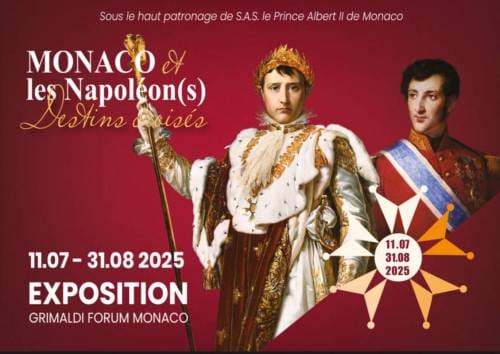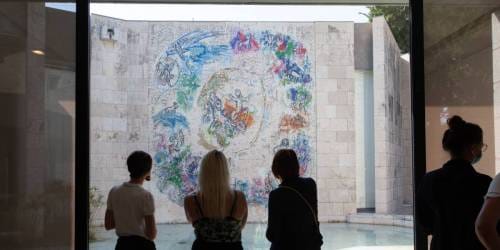The Prince’s Palace of Monaco is the resplendent official residence of the Sovereign Prince of Monaco, Prince Albert II, and of his wife, Princess Charlene and their twins, Princess Gabriella and Prince Jacques.
Although Monaco has existed since ancient times, it wasn’t until 1191 that a residence was built – initially as a fortress of the Genoese granted by the German Emperor Henry IV to protect the coastline from pirates.
Genoa was a wealthy nation in the 12th century, as its people were merchants and often acted as bankers for other nations. But, per the Monegasque Princely Family’s official website, “When the Holy Roman Emperor Frederick II… challenged the authority of Pope Innocent IV, the Genoese divided into two parties: the Guelphs sided with the pope and the Ghibellines with the German Emperor. The Grimaldis belonged to the Guelphs…”
Eventually, in the late 13th century, the Ghibellines won and ousted the Guelphs (and the Grimaldis) from Genoa. But in January 1297, François Grimaldi disguised himself as a monk and sought refuge at the fortress. He murdered the guard, and his men came to help him capture the fortress. For the next 30 years, the fortress was fought over, and in 1341, the first Lord of Monaco, Charles I began his reign.

In the 1400s, the Grimaldi Family purchased Monaco and became the official owners and rulers of the Principality. Monaco was a protectorate of France until the French Revolution in 1814. In 1815, the Kingdom of Sardinia took over as protectorate. In 1860, Monaco became a French protectorate again, until 1918 when the Franco-Monegasque Treaty limited the protection.
It wasn’t until the reign of Honore I in the 1500s that the fortress on the Rock of Monaco was transformed into something resembling a palace, and this is what the modern version of the Prince’s Palace is based upon.

“In the courtyard, architect Dominique Gallo designed a portico with two double-decked galleries, each with twelve arches, with white marble balustrades on the upper gallery, which is known as the Gallerie d’Hercule,” reads the Princely Family’s official website.
“A new wing was constructed on one side of the courtyard, and Genoese painter Lucas Cambiaso was commissioned to paint frescoes on the walls.”
A new tower was built and reinforced with additional towers and a cistern that could hold 3,963 gallons of water – enough to provide 1,000 soldiers for a 648-battle.
Over the ensuing centuries, the Sovereign Princes of Monaco updated the Prince’s Palace to include and expand the State Apartments and State Rooms, art collections, and other additions.

Prince Rainier III is credited for restoring the Prince’s Palace to its glory, and shortly after his accession, he began a full-scale restoration and renovation project.
“Many of the external frescoes on the courtyard were restored, while the south wing, destroyed following the French Revolution, was rebuilt,” reads the Prince’s Palace Wikipedia entry.
The Prince’s Palace of Monaco is open to visitors during the summer months, closing in October every year. Prince Albert II uses the Palace for official functions, receiving Monegasques in the Gallery and using the State Apartment for official receptions and for the annual Christmas Party for Monegasque children.
The courtyard is used by the Monte Carlo Philharmonic Orchestra for open-air concerts and has been since 1960.
In the court of honor, a horseshoe-shaped staircase inspired by the one in Fontainebleau leads to the main entrance of the palace and the open Gallery of Hercules. Then on the way to the throne room, visitors walk along an enfilade of rooms and galleries: the long Mirror Gallery which was inspired by the Hall of Mirrors in Versailles is followed by the Officer’s Room and then by the Blue Room, a large drawing room decorated with blue brocade. The ultimate room at the end of the ceremonial route is the Throne Room with ceiling frescoes painted by Orazio de Ferrari depicting the surrender of Alexander the Great. The throne was made in the Empire style and is placed beneath a red silk canopy topped with a gilt crown. The throne room has host state ceremonies since the 16th century.

The State Apartments feature lavish furnishings and expensive works of art, marble floors and stairways, Renaissance ceiling frescoes, and panelled walls. The state apartments and the throne room can be visited on a guided tour.
The State Apartments are “inlaid in marble with mosaic designs including the double R monogram of Prince Rainier III. The Florentine and Bouille furniture is from the reign of Francois I,” according to the family’s official website.
“The walls are draped in silk brocade and damask and hung with royal portraits executed by well-known artists…all these attest to the devotion to art that is constantly being renewed.”
The State Apartments include:
– The Red Room, which is “furnished in the style of Louis XV” and features art by Jan Breughel, Mignard and Charles Le Brun.
– The York Room, named after the Duke of York (brother of King George III), who died in Monaco in 1787. The Room features frescoes that highlight the four seasons, done by Gregorio de Ferrari and royal portraits
– The Yellow Room, also known as the Louis XV bedroom, and features period furniture and tapestries.
– The Officers Room, which is used by the Protocol Office
– The Blue Room, which is used for the official receptions and is named for the blue silk brocade that lines the walls, and features Grimaldi portraits and Venetian chandeliers.
– The Throne Room, where all official ceremonies take place
– The Mazarin Room, which features “ornate Italian woodwork done by Italian artists brought to France by the Cardinal,” explains the family’s website
– The Louis XII Bedroom
– The Matignon anti-room
– The State Hall, connecting the eastern and southern wings of the Palace, and which leads to the dining room and the Private Apartments with a marble staircase.
Sources: royalcentral.co.uk and frenchmoments.eu
Photo sources: www.secretearth.com, photos.monte-carlo.mc and www.palais.mc








